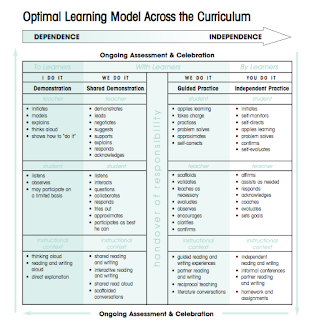My Thoughts on Implementing Digital Tools and Pedagogy
During my studies for my Masters of Education with a focus on technology, I have been looking at mobile learning and the pedagogies that are being developed to support m-learning in schools.
In my role, I often introduce new tools to teachers. My personal pedagogy was to follow Regie Routman's 'Optimal Learning Model' since I found as a classroom teacher who used the Reading and Writing Workshop in her classroom that it was a solid way to individualize instruction. Generally, I begin with a pilot program and gather teachers together to demonstrate the tool and if they are keen then we move ahead and get trial. In another, longer session we explore the tool further, co-plan some lessons and assessments as well as develop a survey or other tool to assess the impact the tool has on student learning. As we move forward, we co-teach lessons and then the guided practice happens amongst teachers and students, we learn together. The final stage is to set the students free and guide the individuals that require further support. Of course, there are always some technical issues to sort out with along the way but that is also part of my role to communicate between a products tech team and our school's tech team. But if everything goes to plan, we then finish the pilot by assessing the tool, assessments are done by all the stakeholders: students, teachers and myself. If all goes well, these teachers and often the students become experts in our wider implementation. Reflection is critical for all stakeholders since it as that point where people have time to get creative.
In my role, I often introduce new tools to teachers. My personal pedagogy was to follow Regie Routman's 'Optimal Learning Model' since I found as a classroom teacher who used the Reading and Writing Workshop in her classroom that it was a solid way to individualize instruction. Generally, I begin with a pilot program and gather teachers together to demonstrate the tool and if they are keen then we move ahead and get trial. In another, longer session we explore the tool further, co-plan some lessons and assessments as well as develop a survey or other tool to assess the impact the tool has on student learning. As we move forward, we co-teach lessons and then the guided practice happens amongst teachers and students, we learn together. The final stage is to set the students free and guide the individuals that require further support. Of course, there are always some technical issues to sort out with along the way but that is also part of my role to communicate between a products tech team and our school's tech team. But if everything goes to plan, we then finish the pilot by assessing the tool, assessments are done by all the stakeholders: students, teachers and myself. If all goes well, these teachers and often the students become experts in our wider implementation. Reflection is critical for all stakeholders since it as that point where people have time to get creative.
My professor Robert Power has developed a pedagogy for m-learning, the Collaborative Situated Active Mobile (CSAM) learning strategy.
Some similarities are that it focuses on the importance of collaboration in learning, which is a key component in building understanding and knowledge as a community of learners. Another common factor is "situated in realistic context" (Power, 2013) and as a teacher I feel this means that the tool is used authentically, teaching a tool in isolation is not ideal and often happens in a fixed schedule and this is why an integrated model is ideal and a schedule that allows some flexibility is best. Active is something we want all our learners to be, active in their use of a skill, in acquiring knowledge and in sharing details. Lastly, the mobile piece is an interesting one, many of my library subscriptions are accessed using a mobile device, in my case an iPad so it's a matter of convenience.
In my opinion, the best course of action to implement mobile learning is to treat adults the same as we teach kids when learning something new. Many schools I have been in seem to struggle with this when implementing new initiatives. We must remember that teachers have different learning styles, different levels of expertise. And just like our students, we need tools demonstrated, time to explore, time to try it out and most importantly time to reflect and be innovative with the new tool.
References
Power, R. (2013). The CSAM Framework. Retrieved October 28, 2018, from Power
Learning Solutions: The CSAM Framework website:
http://www.powerlearningsolutions.com/csam.html
Routman, R. (2012). Teaching Essentials. Retrieved October 28, 2018, from Regie
Routman: Teaching Essentials website: http://www.regieroutman.com/
teachingessentials/




Comments
Post a Comment
Sharing is caring! If you have a comment or feedback, I'd love to hear it.